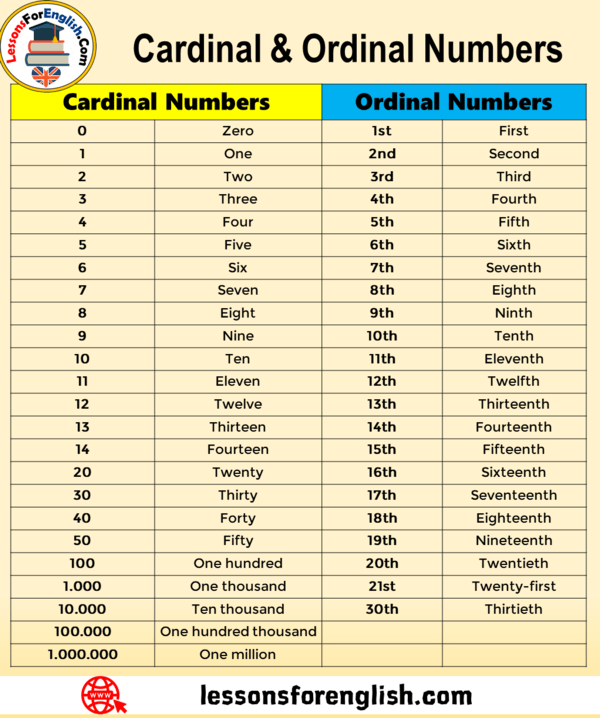
Cardinal & Ordinal Numbers in English Lessons For English
Nominal Numbers Finally, a quick word on 'nominal numbers'. These are numbers that 'identify' something instead of counting or ordering it. A telephone number, for instance, is a 'nominal' number because it doesn't relate to a quantity or rank of something: it's simply a number associated with a phone line.
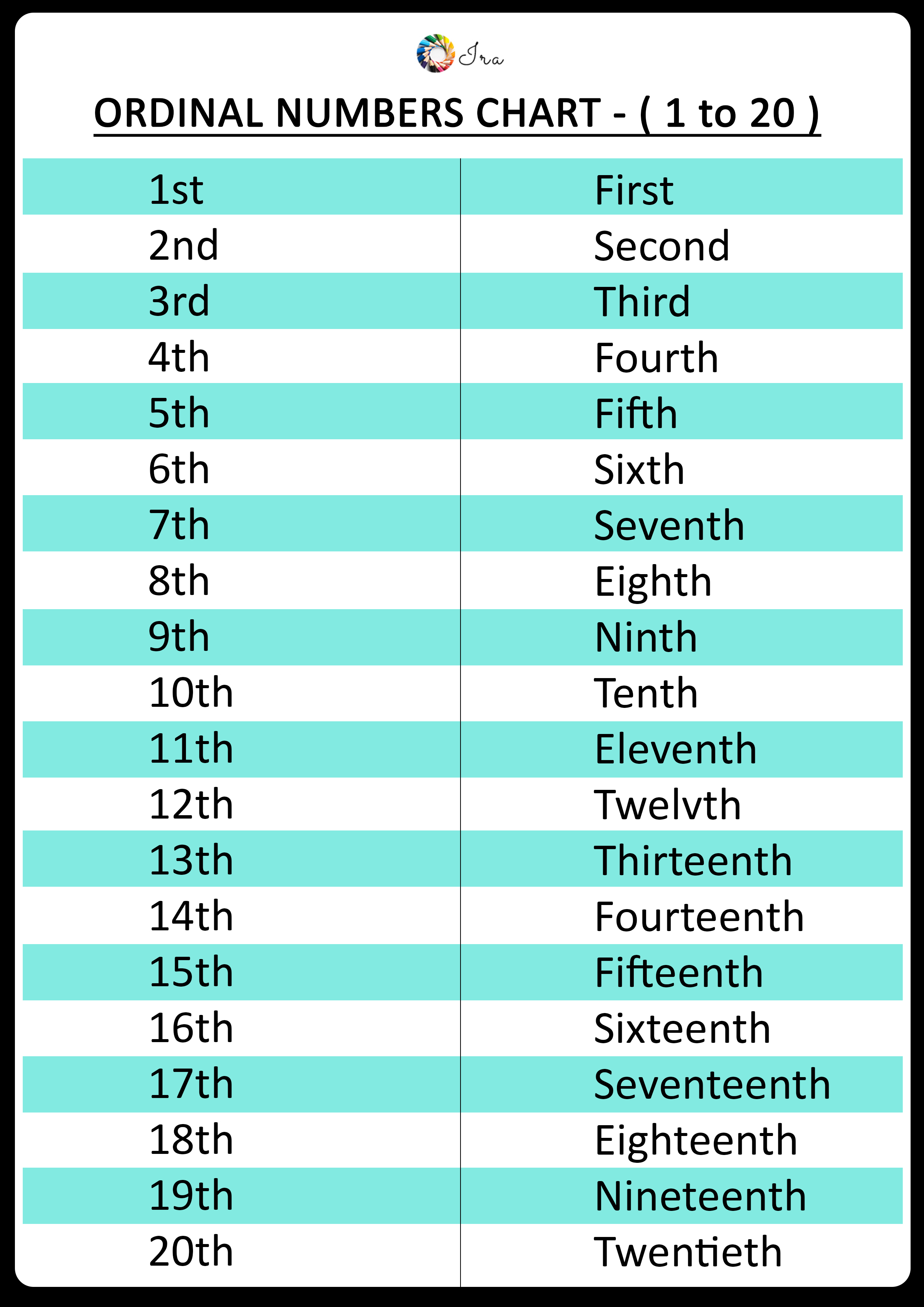
Cardinal And Ordinal Numbers List Pdf cupeg
We use cardinal numbers for counting (think cardinal = counting). Ordinal numbers all use a suffix. The suffixes are: -nd, -rd, -st, or -th. Examples: 'second' (2nd), 'third' (3rd), 'first' (1st), and 'tenth' (10th). We use ordinal numbers for dates and the order of something (think ordinal = order).

Cardinal Numbers and Ordinal Numbers in English English Study Here
Cardinal numbers—also known as counting numbers—are used to specify quantities (i.e., they identify how many). They are what come to mind most often when we think of numbers. Unlike ordinal numbers, they do not specify rank, order, or position. AP advises to spell out one through nine: Blaine has two dogs, and Ray-Ray has five.

Perbedaan Cardinal dan Ordinal Numbers Zenius Blog
Difference between Ordinal & Cardinal numbers The key points of difference between these numbers are listed as follows: Cardinal numbers help us to quantify an object or its magnitude. At the same time, ordinal numbers help us denote an object's location or position in a given space.
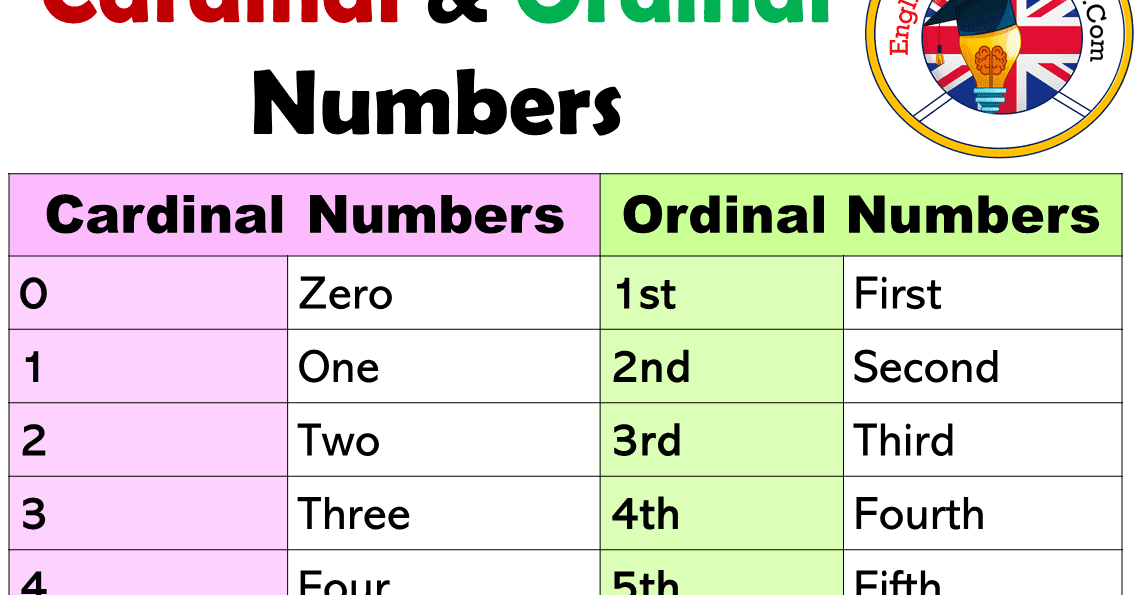
Miriam's Magic Backpack CARDINAL & ORDINAL NUMBERS
Define ordinal numbers: ordinal numbers are numbers denoting an item's place in a series. In summary, Cardinal numbers are numbers that represent how many of something someone has. These are numbers like one, two, three, and four. Ordinal numbers are numbers that represent place or position. These are numbers like first, second, third, and.
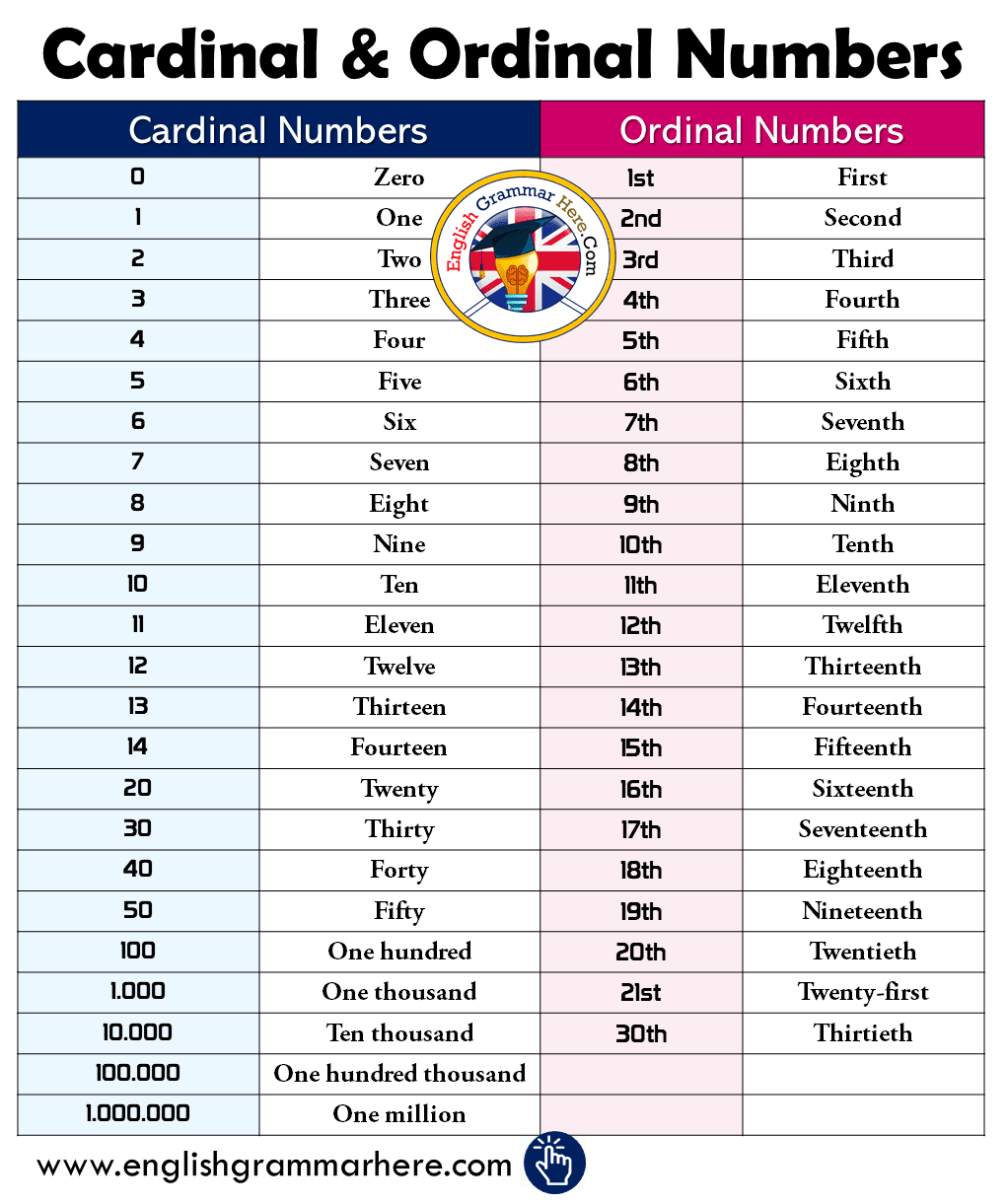
The Cardinal and Ordinal Numbers.
An Ordinal Number tells us the position of something in a list. 1st, 2nd, 3rd, 4th, 5th and so on (see Cardinal and Ordinal Numbers Chart for more.) Example: In this picture the girl is 2nd: And the two pups are 3rd and 4th. How to remember: " Ord inal says what Ord er things are in". Nominal Numbers

EduBlog EFL Cardinal and ordinal numbers.
two → second (2nd) three → third (3rd) Note also that a Cardinal ending in "-y" becomes "-ieth" for the Ordinal. Examples: 70 (seventy) → 70th (seventieth) 71 (seventy one) → 71st (seventy-first) 194 (one hundred ninety four) → 194th (one-hundred-ninety-fourth) Cardinal, Ordinal and Nominal Numbers Numbers Index

Cardinal, Ordinal and Roman Numerals Examples English Grammar Here
Writing dates: the cardinals vs. the ordinals by Editarians | Oct 29, 2021 | Ask the Editor | Question: When I'm writing something that has dates included in it, how do I know when to use 1st or 5th when listing a date instead of just writing the number by itself? What is this called, anyways? When to use cardinals and when to use ordinals

Cardinal & Ordinal Numbers English Study Here
Cardinal numbers are basically those numbers which provide us the exact quantity of an object, meaning how many of something such as five, seven, eight, ten etc. Simply to say, cardinal numbers answer "How many?" For example: The given picture shows 4 oranges in a basket. Hence, 4 or 'four' here represents a cardinal number.

Cardinal and Ordinal Numbers Classroom101
Whereas the notion of cardinal number is associated with a set with no particular structure on it, the ordinals are intimately linked with the special kind of sets that are called well-ordered.

Cardinal and Ordinal Numbers Chart
- The Washington Post When to Use Ordinal Numbers What is an ordinal number? Ordinal numbers are numbers that signify relative position, like first in line at the café, second person to comment on Brenda's new glasses this morning, or third time Kendall has had to tell her friends that she works Friday nights and can only go dancing on Saturdays.

Cardinal and Ordinal number chart English ESL worksheets pdf & doc
Cardinal numbers are the numbers we count with and probably what you think of first when you hear the word 'number'. For example, one, two and three are all cardinal numbers. A selection of cardinal numbers. You can write these numbers as either words (e.g. eight) or numerals (e.g. 8).
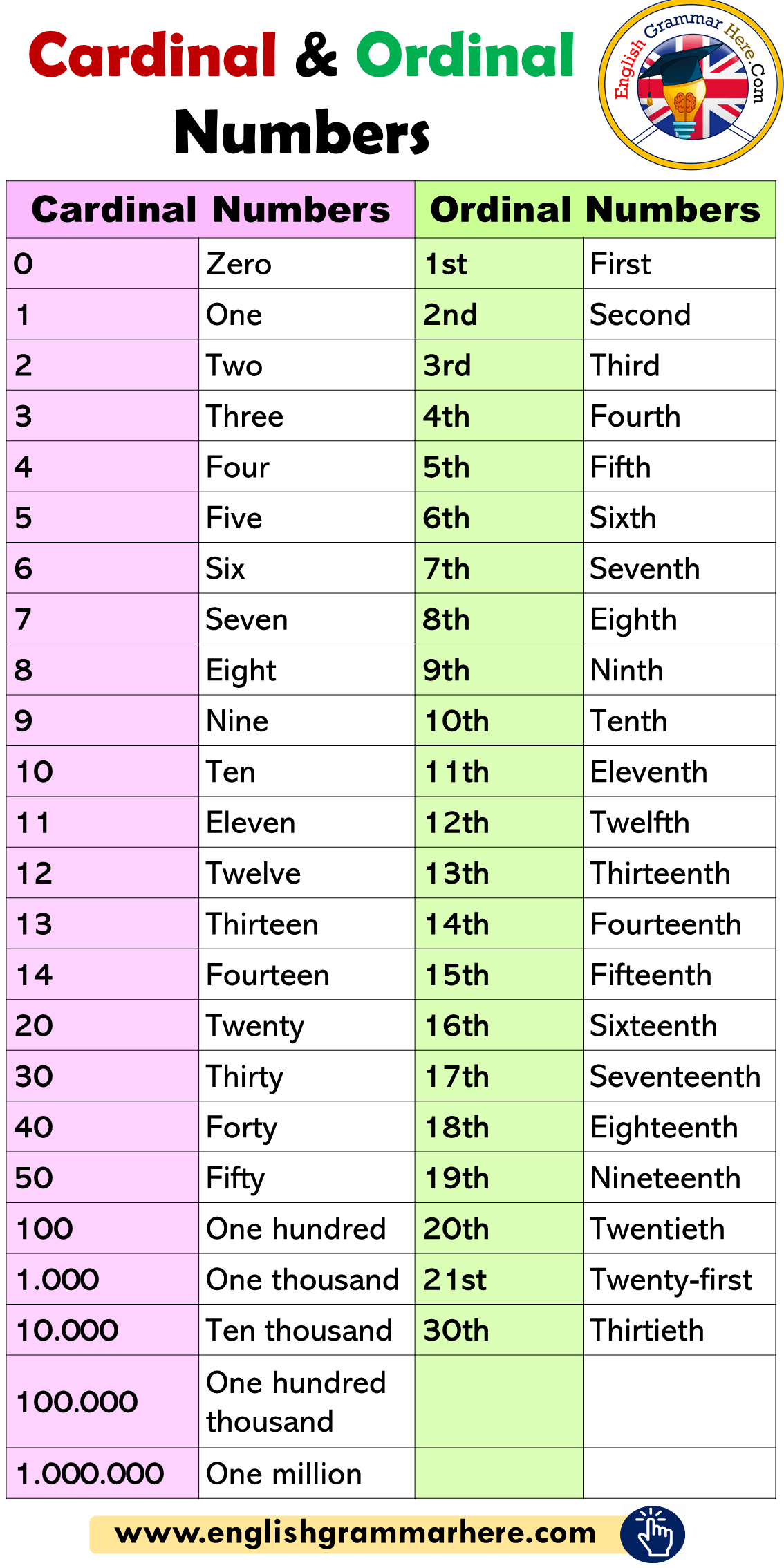
Cardinal and Ordinal Numbers List English Grammar Here
Cardinal numbers, known as the "counting numbers," indicate quantity. Ordinal numbers indicate the order or rank of things in a set (e.g., sixth in line; fourth place). Nominal numbers name or identify something (e.g., a zip code or a player on a team.) They do not show quantity or rank.

Cardinal And Ordinal Number Pengertian Penggunaan Dan Contoh Gambaran
Frank has five pens. The cardinal number here is five as that is how many pens he has. Laura came second in the spelling test as she got nine questions right. Here the cardinal number is nine as that is the number that is telling us how many questions she got right. Helen has two dogs and three cats.
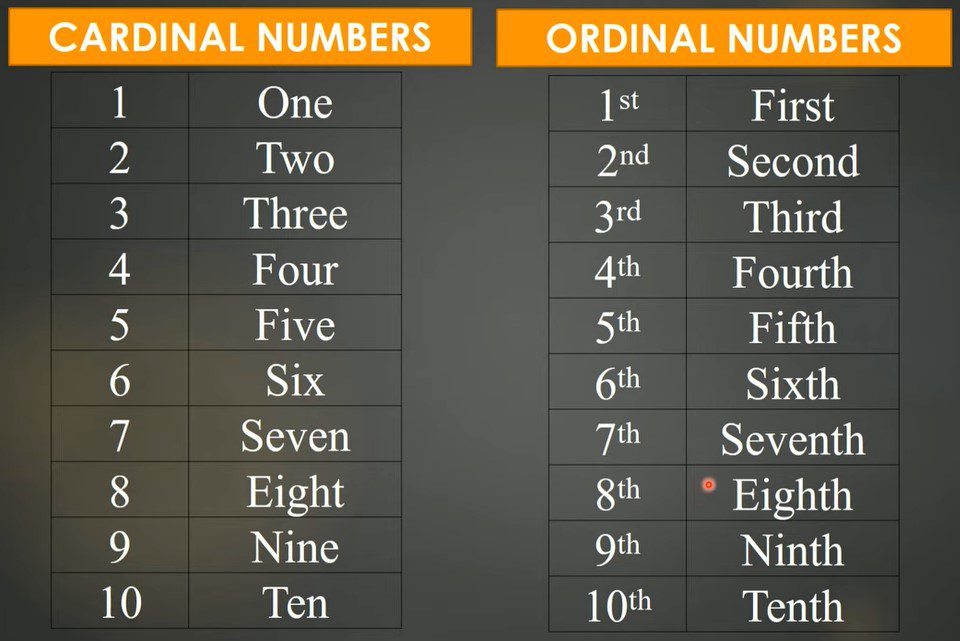
Diference of Cardinal and Ordinal Numbers Sinaumedia
Ordinal vs. cardinal numbers: the key differences Practical exercises Cardinal numbers in English First things first, we've got to cover the basics: cardinal numbers. These are the numbers that you likely think of when you think of numbers: one, two, three, etc. These help us discuss things when their order doesn't really matter.

Cardinal Numbers, Ordinal Numbers and Roman Numerals English Study Here
They answer the question "how many?" and are used to denote the exact number of objects or events in a set. Cardinal numbers are typically used in counting, measuring, and performing mathematical operations. For example, in the sentence "There are 5 apples on the table," the number 5 is a cardinal number.